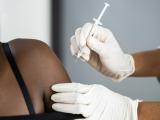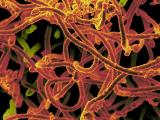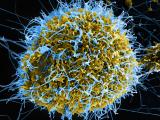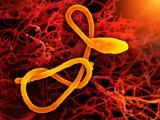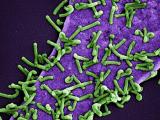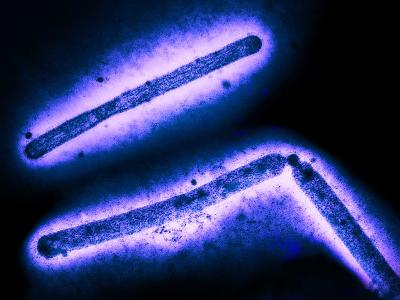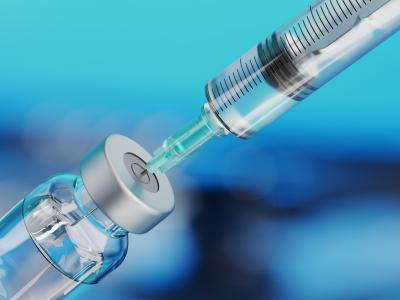Ebola's impact on the United States reached far beyond Texas today, as federal and state health officials revealed preliminary test results indicating infection in a second nurse who had flown to Dallas from Ohio hours before she reported having a fever.
The woman's travel history triggered notification today of 132 passengers on Frontier Airways flight 1143 from Cleveland to Dallas-Fort Worth on Oct 13, the US Centers for Disease Control and Prevention (CDC) said today.
Though the nurse didn't have any illness symptoms during the flight and isn't thought to have been infectious then, the short period between the evening flight and her fever report the next morning has the CDC acting out of an abundance of caution, the agency said.
Nurse also helped care for Duncan
The Texas Department of State Health Services (TDSHS) said today that the second infected nurse reported a low-grade fever yesterday and was immediately isolated at the hospital. The Dallas media identified her as 29-year-old Amber Joy Vinson. As with the first infected nurse, Vinson had helped care for the Liberian man, Thomas Eric Duncan, who died at Texas Health Presbyterian Hospital in Dallas on Oct 8.
At a media briefing today, CDC Director Tom Frieden, MD, MPH, said the nurse had extensive contact with Duncan when he was having substantial amounts of diarrhea and vomiting. He said Vinson will be taken to Emory University Hospital's special isolation unit in Atlanta for treatment, and a Dallas Morning News story today said she had been flown there today.
The hospital said in a statement today that she is in good condition. Dallas health officials said no symptoms have been reported in 75 other health workers who may have had the same exposure as the two nurses. Also, no symptoms have been noted in the one contact of the first sick nurse—Nina Pham—or in the 48 people originally identified as Duncan's possible contacts.
Federal and state health officials are deeply concerned that others in Duncan's care team may have had similar exposure and have warned that more Ebola infections may be detected in the group.
Earlier in the day at a press conference in Dallas that was broadcast live on the local ABC affiliate, WFAA, Mayor Mike Rawlings said Vinson lives alone and doesn't have any pets. As for Pham, city officials sent a reverse 911 call to nearby residents and provided literature about Ebola to neighbors, and cleaning teams began decontaminating her apartment and car.
Nurse's flight triggers passenger notification
The CDC this morning asked travelers who took the Frontier Airlines flight to call the agency and said that the airline is working closely with the CDC to identify and notify passengers. It said public health officials will begin interviewing passengers this afternoon, and those found to be at potential risk will be actively monitored.
Frontier Airlines said in a joint statement with the CDC today that it learned about the nurse's travel at 1:00 am today. It said the flight landed in Dallas at 8:16 pm on Oct 13 and the plane was cleaned using normal procedures, which are consistent with CDC guidelines. The company said the plane was cleaned again in Cleveland last night. It added that the woman's initial flight to Cleveland was on Oct 10 on Flight 1142.
Frieden said the nurse flew to Ohio before Pham's Ebola infection was known. Because she was self-monitoring, Vinson should not have traveled and should not have been allowed to travel. People who are self-monitoring should travel only in controlled setting, such as private vehicles, Frieden said. Her temperature the day of the flight was 99.5°F.
He said the chance of the woman transmitting the virus during the flight is extremely low, "but we're putting in place extra layers of safety."
Kent State asks three workers to self-monitor
In a related development, Kent State University (KSU) today announced that Vinson is related to three of its employees and that she didn't have symptoms when she traveled to Cleveland from Oct 10 to Oct 13.
In a statement, KSU said the woman wasn't on campus and had stayed with her family at their home in Summit County. It said that, out of an abundance of caution, it has asked the woman's family members to remain off campus for the next 21 days and monitor their health.
Probe focuses on PPE
The second infection in a health worker comes a day after the CDC announced steps to shore up personal protective equipment (PPE) and infection control guidelines for managing Ebola patients. The steps came in the wake of charges from National Nurses United (NNU), the nation's largest registered nurses' union, that Texas Health Presbyterian Hospital didn't have PPE protocols and had inconsistent guidelines that were confusing for employees.
In a fact sheet yesterday outlining its steps, the CDC said it has deployed a second team to the Dallas hospital to assist with infection control and monitoring health workers. The team includes professions from Emory's special isolation unit and some who have worked with Doctors without Borders, a group that is known for its highly disciplined PPE practices.
It said the focus of the investigation at the Dallas hospital centers around what type of gear the staff wore, how it was donned and doffed, procedures done on Duncan that may have exposed the nurses, decontamination after workers left the isolation unit, oversight, and what other training may be needed.
Though it hasn't identified a source of exposure, the CDC said immediate recommendations for the facility include standardizing PPE, possibly employing full body suits, ensuring consistent training in PPE use, use of a hood model that protects workers' necks, and detailing steps for hand disinfection and PPE removal.
Frieden, at today's media briefing, said there are several right ways to wear PPE, but he added that employees who use familiar PPE in familiar ways are more likely to do it right.
Yesterday the CDC announced that it will send an Ebola response team to any US hospital that identifies an Ebola patient. It also provided details on a host of conferences and webinars, including one tomorrow with the American Hospital Association and one on Oct 20 for healthcare workers.
Nurses union demands better training, protection
NNU said, based on reports from Dallas nurses, that Duncan's lab specimens were sent through the hospital pneumatic tube system, nurses initially had gowns that weren't impermeable, and N95 respirators and face shields were optional. Suits given to nurses exposed their necks, and the nurses secured them with medical tape, which isn't impermeable.
NNU raised the concerns, based on reports from unnamed nurses at the Dallas hospital, at a media briefing yesterday and detailed them in a press release and during a national conference call today.
The group said advance training consisted of an optional seminar, and even after Duncan was hospitalized for Ebola, training was limited and didn't include practice PPE donning and doffing for every nurse. Some nurses said hospital preparedness consisted only of leaflets on PPE for Ebola and short in-services.
"Nurses had to interact with Mr. Duncan with whatever protective equipment was available, at a time when he had copious amounts of diarrhea and vomiting which produces a lot of contagious fluids," NNU said.
The hospital's parent company, Texas Health Resources, said in a statement that patient and employee safety is its top priority and it takes compliance very seriously. It said it has numerous measures in place to provide a safe environment, including mandatory annual training, an around-the-clock hotline, and mechanisms that allow anonymous reporting. It said it would review and respond to any concerns nurses and employees have.
During the NNU call today, the group aired a letter outlining its concerns that it sent to President Obama, other lawmakers, and public health officials. Nursing organizations from Spain and Liberia weighed in with similar concerns, and nurses from different parts of the United States called in to describe the experiences at their hospitals.
A common complaint was that hospitals had only generic gowns and other gear, instead of properly sized hazmat type gear. One nurse from Washington, DC, said her hospital couldn't afford goggles: "It's a mess. We need help."
Lisa Brosseau, ScD, who coauthored a Sep 17 commentary published on CIDRAP's Web site on the potential for Ebola to be transmitted by infectious aerosol particles and the need for better PPE, addressed the group. She said that when the first Ebola case was identified in Dallas, she assumed US hospitals would be ready, given their experiences with tuberculosis, pandemic flu, and SARS.
She said, though, that she is shocked and saddened to know that two nurses have been infected. She put the blame for lack of hospital Ebola preparedness at the door of the CDC, which she said has not incorporated the expertise of worker safety groups such as the National Institute for Occupational Safety and Health (NIOSH) and the Occupational Safety and Health Administration (OSHA) into its planning.
Brosseau is a professor in the School of Public Health, Division of Environmental and Occupational Health Sciences, at the University of Illinois in Chicago.
West Africa cases approach 9,000
The Ebola infection pattern in all three outbreak countries continues to deteriorate, with continuing problems with data gathering and reporting in Liberia clouding some of the assessment there, the World Health Organization (WHO) said today in its latest update. Though a vast undercount of the disease's true burden, the total through Oct 12 is 8,997 infections and 4,493 deaths, it said.
The total reflects an increase of 598 infections and 460 deaths since the WHO's late update on Oct 10.
Widespread and persistent Ebola transmission in Guinea, where disease levels have ebbed and flowed over the outbreak months, is driven by a spike in cases in the capital Conakry and in nearby Coyah district. In Sierra Leone, intense transmission is still occurring in Freetown, the capital, and in surrounding districts, the WHO said.
Corporate preparedness concerns
- Absence of a fever doesn't necessarily guarantee that a person is not infected with the Ebola virus, said Michael T. Osterholm, PhD, MPH, at a webinar today on corporate preparedness for Ebola. Therefore, travelers who return from an Ebola-hit country and have suggestive symptoms but don't have a fever should "absolutely" be tested for the disease, he said. Osterholm, director of the University of Minnesota's Center for Infectious Disease Research and Policy (CIDRAP), publisher of CIDRAP News, said 10% to 20% of Ebola patients may present without a fever.
- Worries about Ebola may be slowing the US military response to the Ebola crisis in Liberia, said another expert who spoke during the same webinar. Myles Druckman, MD, senior vice president of medical services at International SOS, a travel security firm, said US contractors supporting the US military in Liberia are concerned about how Ebola risks will be managed. "A lot of the contractors who are being asked to go in-country to support the military are asking, 'What's the plan, guys?'" he said. "I think that's definitely holding up some of the relief effort to support the US military." Osterholm commented that now, a month after President Obama promised to send 3,000 troops to Liberia, only 300 troops have been sent and no new treatment beds or hospitals have yet been provided.
- Evacuating a sick visitor from an Ebola-hit country is very difficult, even if he or she is known not to have Ebola, Druckman said during the webinar. "Basically the stars have to align," he said. "While it is possible, it's extremely challenging, and it has to be on a dedicated aircraft." If a person actually has Ebola, evacuating him or her requires a government/military operation, he added.
Other developments
- As news reports reveal breaches in 21-day quarantine measures in some people exposed to Ebola patients, a study yesterday in PLoS Currents Outbreaks suggests that 3 weeks might not even be long enough. Charles N. Haas, PhD, of Drexel University in Philadelphia said the origin of the current oft-cited 2- to 21-day incubation period is unclear but is possibly based on studies of either a 1976 Zaire or a 2000 Uganda outbreak, both of which cited the 21-day figure without detailed analysis. Haas used data from previous outbreaks and the first 9 months of the current West Africa outbreak to determine that 0.1% to 12% of patients have onset of symptoms longer than 21 days after exposure. The lower number is derived from the 1976 Zaire outbreak, which had the fewest cases.
- Today the National Institute of Allergy and Infectious Diseases (NIAID), part of the National Institutes of Health, announced a license agreement for advancing dual-purpose candidate vaccines to protect against both rabies and Ebola. The vaccines were created by scientists at NIAID and Thomas Jefferson University in Philadelphia and are being further developed through a partnership with the German company IDT Biologika, the agency said in a news release. The vaccines are now licensed to Exxell BIO of Saint Paul for advancing them through clinical trials and commercial use. The vaccines are based on currently used rabies vaccines.
- The Public Health Agency of Canada has sent health officials in Spain and Norway a laboratory-grade version of the Ebola drug ZMapp for treating patients in the two countries, the Canadian Press reported yesterday. A national lab in Winnipeg sent the nations one treatment course each of ZMab, a monoclonal antibody drug developed at the lab for animal research. An unnamed expert said the move is unusual but added that it's an unusual time.
News editor Robert Roos and editorial director Jim Wappes contributed to this report.
See also:
Oct 15 TDSHS statement
Oct 15 CDC statement on infection in second nurse
Oct 15 Texas Health Resources statement on second infected nurse
Oct 14 CDC fact sheet on hospital Ebola preparedness
Oct 15 NNU statement on PPE at Dallas hospital
Oct 14 Texas Health Resources statement on healthcare worker protection
Oct 14 Texas Health Resources statement on Nina Pham's condition
Oct 15 CDC statement on flight contact tracing
Oct 15 KSU statement
Oct 15 Dallas Morning News story
Oct 15 WHO Ebola situation update
Oct 14 PLoS Curr Outbreaks study
Oct 15 NIAID news release
Oct 14 Canadian Press story


